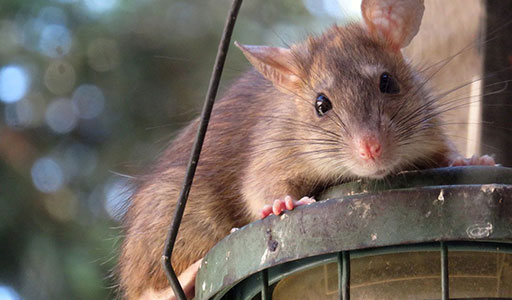Roof Rat Control
Do you need to get rid of Roof Rats? We can help!

Roof Rat Removal Strategies
Roof rats are small rodents with brown and black fur and white bellies. These rats get their name from their tendency to seek shelter in the upper level of buildings and structures. Once inside your home, roof rats may cause damage with their teeth as well as by spreading potentially dangerous diseases. Whether you live in an overpopulated city, rural countryside, or suburbia, you may be all to familiar with the sound of roof rats in your attic.
Don’t waste your time or money on DIY rat traps that don’t solve your rat problem. Call in the team of experts at Trutech for roof rat removal and roof rat control services that are effective and permanent solutions. Hiring a team of professionals from Trutech will fix all of your wildlife problems in an environmentally sensitive way. Our specialists have the tools and knowledge necessary to prevent the spread of diseases from roof rats that enter into your home.
Trust Trutech to solve your roof rat issues in the most thorough, humane, and environmentally sensitive manner. Don’t wait until rats have invaded your home, garage, and yard to call in a professional team- Call Trutech to implement the necessary roof rat control and roof rat removal services in your home, yard, or garage. Our specialists will help you regain your peace of mind through a rat-free property.
Roof Rat Problem

Signs a Roof Rat is on Your Property
Roof rats in attics can cause quite a bit of damage. Their incessant need to gnaw leads them to chew into structural beams and through electrical wiring, causing fuses to blow and creating the risk of fire. Unlike Norway rats, which leave feces and urine stains all over lower level floors, roof rats in attics tend to spend their days between floors, in utility spaces, and above false ceilings. The mess they leave remains hidden, which leads to a foul odor and a difficult clean-up job. If droppings are found in open spaces, it is likely a sign of a significant infestation. Roof rats are also capable of spreading leptospirosis, rat-bite fever, and plague.

Dangers of Roof Rat Infestation
Diseases such as rat-bite fever, plague, leptospirosis, and typhus are known to be spread by roof rats. Simply by invading homes and yards, the pests can transmit these diseases to humans through their urine, droppings, fur, and saliva. Additionally, roof rats damage buildings by chewing and destroying wiring and tearing up insulation to use for nesting material. Stored food can also fall victim to the rodents and provide them with meals.
Humane Roof Rat Removal & Control Strategies

Entry into property
Attics, basements, wall voids, and cabinets provide roof rats with hidden and covered spaces. As the pests seek food, warmth, and protection, roof rats often enter homes. Yards are generally even more at risk of infestations since they provide both shelter and vegetation. Roof rats favor vines and ivies but also live in gardens, tree orchards, and landscaped yards, as these areas supply the pests with food and nesting sites.

Trapping & Removal
Roof rats commonly live on branches, ledges, and shelves, so properly placing traps under these locations can help with control and removal. Garages, sheds, and attics are other common sites of roof rat nests where traps can be set. However, while wooden mouse and rat traps are often used to capture roof rats, the professional wildlife removal services of Trutech can handle the problem most effectively. Our specialists are trained to trap, remove, and prevent roof rats efficiently and safely.

Prevention & Exclusion
As the pests like vines and ivies, removing these plants minimizes the chance of roof rat infestations in yards. Sources of moisture should also be eliminated or maintained, since roof rats must live near water to survive. Furthermore, by keeping trash and food supplies properly stored and securely sealed, the pests are less likely to invade and settle in homes.
Frequently Asked Questions
Roof rats are harder to trap than other rodents because they avoid new objects placed in their environment. Rather than showing curiosity, they are wary. When considering roof rat traps, the snap trap is the most common choice, as it’s usually inexpensive. Cleanup, however, is distasteful and possibly dangerous, as it involves coming in contact with the disease-ridden body of a dead rat. All roof rat traps bring with them some necessity of getting close to rats that are dead or alive. Poisons have their own problems, as the pests can decay behind walls and cause a pungent odor that lasts for weeks.
Often unspoken in the discussion of roof rat traps are the hard-to-reach places where they will need to be positioned. The rodents can work their way into tight quarters, forcing human adversaries to climb, crawl, and stretch their way in. These environments are often hot, cramped, dusty, and dirty, and come with the added risk of inhaling diseased particles of dried rat feces. For a hands-free solution that doesn’t involve exposure to filth or disease, contact the wildlife removal experts at Trutech.
To eliminate roof rats in the attic, rodent-proofing begins up high. Look to the roofline to ensure that all gaps and cracks one-half inch or greater are covered with metal flashing or steel wool. Cut back overgrown vines and branches to avoid giving these agile pests easy access indoors. It also helps to remove their food sources by keeping kitchens clean of crumbs and liquid spills. Trapping roof rats in attics can be difficult because of the cramped space, as well as the danger of kicking up dust from disease-ridden feces and dander. Therefore, the safest and simplest form of removal is to reach out to the professionals at Trutech.


